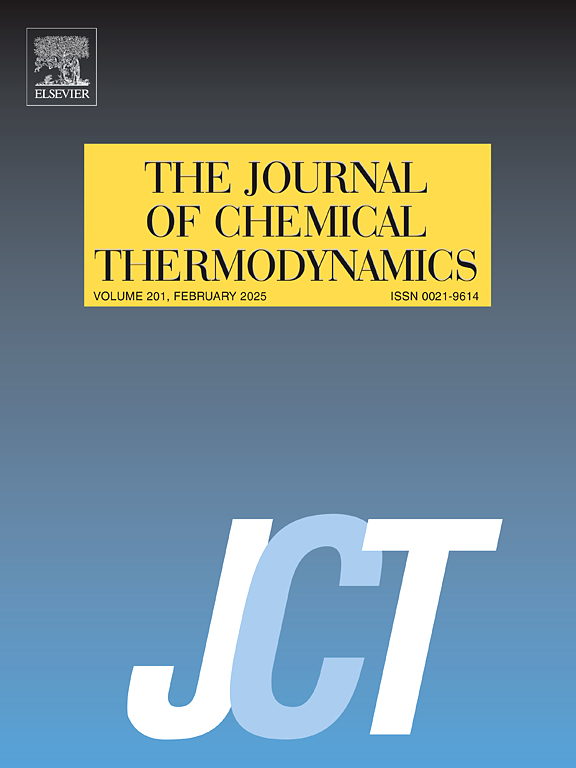298.15 K - 318.15 K下2 -氨基-1-丁醇与异构体丁醇的体积、FT-IR和光学性质应用PFP理论和图理论方法
IF 2.2
3区 工程技术
Q3 CHEMISTRY, PHYSICAL
引用次数: 0
摘要
在298.15 ~ 318.15 K的温度范围和0.1 MPa的压力下,测定了含有2 -氨基- 1 -丁醇(2AB)和异构丁醇二元混合物的密度和光学性质。利用这些测量,计算了多余摩尔体积(VmE)和折射率偏差(ΔnD)。在等摩尔组成下,负的vmev值依次为:叔丁醇>;进行比;异丁醇的在正丁醇,而ΔnD则呈现相反的趋势。应用Prigogine-Flory-Patterson理论和Graph理论方法分别解释298.15 K的VmE数据。此外,GTA还预测了各种组分的分子种类在纯态和混合态下都存在。此外,FT-IR光谱证实了组分分子之间形成了氢键。VmE值随温度升高而减小,ΔnD值随温度升高而增大。在理论计算中采用了不同的混合规则。本研究旨在扩充胺醇混合物的热物理性质数据库,为工程师和科学家开发先进的CO2捕集技术提供参考。本文章由计算机程序翻译,如有差异,请以英文原文为准。

Volumetric, FT-IR, and optical properties of 2–amino-1-butanol with isomeric butanol at 298.15 K–318.15 K using PFP theory and graph theoretical approach
The density and optical properties of binary mixtures containing 2–amino 1–butanol (2AB) and isomeric butanol were measured over a temperature range (298.15–318.15) K and 0.1 MPa pressure. Using these measurements, excess molar volume () and deviation in refractive index () were computed. The negative values, at equimolar composition, follow the order: tert-butanol > sec-butanol > isobutanol > n-butanol, while the exhibit the opposite trend. The Prigogine–Flory–Patterson theory and the Graph theoretical approach were applied to interpret the data at 298.15 K, respectively. Moreover, the molecular species of various components are predicted to exist in both pure and mixed states by the GTA. Furthermore, FT–IR spectroscopy confirmed the formation of hydrogen bonding between the molecules of the components. The values decrease with increasing temperature, while the values increase with increasing temperature. Various mixing rules were applied to calculate theoretically. This study aims to expand the database of thermophysical properties for amine-alcohol mixtures, providing a reference for engineers and scientists developing advanced CO2 capture technologies.
求助全文
通过发布文献求助,成功后即可免费获取论文全文。
去求助
来源期刊

Journal of Chemical Thermodynamics
工程技术-热力学
CiteScore
5.60
自引率
15.40%
发文量
199
审稿时长
79 days
期刊介绍:
The Journal of Chemical Thermodynamics exists primarily for dissemination of significant new knowledge in experimental equilibrium thermodynamics and transport properties of chemical systems. The defining attributes of The Journal are the quality and relevance of the papers published.
The Journal publishes work relating to gases, liquids, solids, polymers, mixtures, solutions and interfaces. Studies on systems with variability, such as biological or bio-based materials, gas hydrates, among others, will also be considered provided these are well characterized and reproducible where possible. Experimental methods should be described in sufficient detail to allow critical assessment of the accuracy claimed.
Authors are encouraged to provide physical or chemical interpretations of the results. Articles can contain modelling sections providing representations of data or molecular insights into the properties or transformations studied. Theoretical papers on chemical thermodynamics using molecular theory or modelling are also considered.
The Journal welcomes review articles in the field of chemical thermodynamics but prospective authors should first consult one of the Editors concerning the suitability of the proposed review.
Contributions of a routine nature or reporting on uncharacterised materials are not accepted.
 求助内容:
求助内容: 应助结果提醒方式:
应助结果提醒方式:


